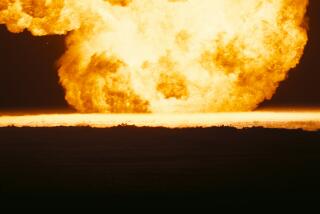Eureka! Gold in universe forged by dead, crashing neutron stars
Astronomers panning the heavens for glints of gamma-ray bursts have struck gold. No, really. They found gold -- so much of it, in fact, that they say they could potentially account for the universe’s entire reserve of the precious metal prized by Earthlings for jewelry and industrial uses alike.
All the gold in the cosmos may have come from stellar cataclysms -- the collision of two neutron stars, which sends bursts of particles and radiation into the universe.
“We are all star stuff, and our jewelry is colliding-star stuff,” said Edo Berger of the Harvard-Smithsonian Center for Astrophysics, paraphrasing iconic astronomer Carl Sagan.
These neutron stars are the incredibly dense, deadened husks left from dramatic stellar explosions known as supernovas. Supernovas are what seeded a hydrogen-rich universe with heavier elements fused in the stars’ cores, like carbon, oxygen or iron. But unlike carbon or iron, gold can’t be forged in the heart of a star, so its origin has remained something of a mystery.
Berger discovered an answer during his search for short gamma-ray bursts. Gamma-ray bursts are flashes of high-energy radiation that signal truly powerful explosions that can come from billions of light-years away. Some of them are long, lasting even a few minutes, and others are incredibly short – fractions of a second, making them very difficult to catch in the act.
Berger was looking for the short ones. And it was a flash in what’s called GRB 130603B, picked up by NASA’s Swift satellite, that caught his attention. When his phone rang at 2 a.m., he and his team quickly moved to examine the short burst – which lasted two-tenths of a second -- captured with the powerful Magellan/Baade telescope in Chile.
The burst appeared to be coming from the collision of two neutron stars -- each roughly the size of Austin and filled with 1.5 times the mass of the sun -- an impact that produced a black hole and the bright burst of gamma rays that they picked up.
But they also saw something else around the bright beacon: A strange glow of infrared radiation. This, the astrophysicists realized, was coming from radioactive elements – like lead, thorium, uranium -- decaying and thus producing the infrared light.
Clearly, the explosion had been responsible for the creation of a whole menagerie of heavy elements. They estimated that an equivalent of 1% of the sun’s matter was being flung out from the collision in a tail, and about 10 parts per million of that tail was made of gold.
They could be seeing perhaps 10 times the moon’s mass in gold, Berger said. The gold out there could be worth around $10 octillion. (That’s $100 trillion squared.)
Combining their estimate of the amount of gold from the neutron star mashup with the estimated number of such explosions since the beginning of time, it could even be that all the gold in the universe came from such exotic collisions, the scientists said. Their paper has been submitted to the Astrophysical Journal Letters.
So while there is indeed gold in them thar stars, should amateur prospectors still panning for the yellow metal lift their eyes from the ground and search the skies instead?
Probably not. This exploding star system is 3.9 billion light-years away. In any case, if such a huge amount of gold ever landed on Earth, “the price would plummet,” Berger pointed out.







